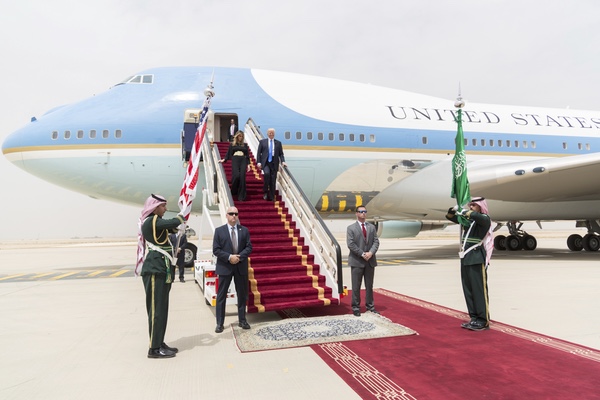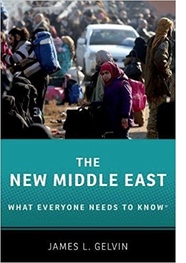The Trump Doctrine in the Middle East Is to Follow Saudi Arabia’s Lead

Saudi Arabia and Qatar are both members of the Gulf Cooperation Council, an association of regional monarchies. It was established to coordinate their economic, political, and even military policies. Wahhabi Islam—a highly puritanical and literalist version of Islam—is the dominant sect in both, and nowhere else.
 Yet on
June 5, 2017, Saudi Arabia, along with the United Arab Emirates,
Bahrain, Egypt, Yemen, Libya and the Maldives imposed sanctions on
the tiny kingdom.
Yet on
June 5, 2017, Saudi Arabia, along with the United Arab Emirates,
Bahrain, Egypt, Yemen, Libya and the Maldives imposed sanctions on
the tiny kingdom.
Saudi Arabia, the UAE, and Bahrain had recalled their ambassadors to Qatar in 2014 because of its support for Egypt’s Muslim Brotherhood president, Muhammad Morsi. That crisis lasted eight months, ending after General Abdel Fattah al-Sisi overthrew Morsi, consolidated power, and cracked down on his enemies. This time, Qatar’s punishment for its alleged transgressions is far more severe. Why is this, and what explains the peculiar timing for this rift?
The current crisis purportedly began over a news story transmitted by the Qatar News Agency. According to the story—which the Qataris claim was fake news planted by hackers—Sheikh Tammin bin Hamad, Qatar’s ruler, reportedly stated, “There is no reason behind Arabs’ hostility toward Iran,” which he described as “a great state that contributes to regional stability.”
He went on to praise Qatar’s relationship with the Muslim Brotherhood, the Palestinian Islamist organization Hamas, and, of all places, Israel.
The Saudis and Emiratis chose to accept the story at face value rather than shrug it off.
Given Saudi Arabia’s record, its indignation at Qatar’s support for what it deems terrorist groups is laughable. So is its anger at Qatar’s supposed tribute to the country that the Saudis hypocritically accuse of being the greatest purveyor of terrorism in the region.
While the leaked news story provided the rationale for Saudi Arabia’s actions, the real reasons for the commotion are deeper and more complex.
The Saudi-Qatari quarrel can be traced to back to the conquests that led to the founding of Saudi Arabia in 1932. Only the fact that Qatar was a British protectorate at that time dissuaded the emerging Saudi state from swallowing up the small spit of land on which Qatar is situated.
In the years following Qatari independence in 1971, Qatar and Saudi Arabia quarreled over boundaries. Qatar also struck out on its own in foreign affairs in an effort to wriggle out from under the thumb of its neighbor.
Then, in 1995, Sheikh Tammin bin Hamad, the current ruler of Qatar, took power from his father in a coup d’état. Monarchs in Saudi Arabia and the UAE viewed the coup as a dangerous precedent and plotted a countercoup. The sheikh was to be assassinated. Tammin caught wind of the plot and crushed it, but the bad blood remained.
Fast forward to 2010-11. During the Arab uprisings, Saudi Arabia and Qatar again found themselves at loggerheads. Qatar became a cheerleader for the uprisings through its news empire, al-Jazeera, and through financial and even military assistance to a number of opposition movements. Saudi Arabia became the epicenter of the counter-revolution. Their divergence was inevitable, given the diametrically opposed survival strategies adopted by the two kingdoms.
Saudi Arabia’s survival strategy rests on two cornerstones. The first is “quietism”—the separation of Islam from politics. This doctrine can be traced back to the eighteenth century theologian, Muhammad ‘Abd al-Wahhab, an itinerant preacher who took up with Muhammad bin Sa‘ud, the founder of the Saudi dynasty.
‘Abd al-Wahhab urged his followers to eschew politics. Making loyalty to a ruler a religious obligation proved useful to Muhammad bin Sa‘ud and his descendants for obvious reasons.
Since its founding, the Saudi kingdom’s pretension to leadership of the world’s Sunni Muslims has been challenged by popular Islamist movements that have had no qualms about blending religion and political activism.
The various Muslim brotherhoods, particularly the Egyptian Muslim Brotherhood, that have defied governments throughout the Muslim world have been Saudi Arabia’s most consistent antagonist in the Sunni camp. They have made no secret of their hatred of the Saudi royal family. Little wonder, then, that the Saudis were appalled by Qatar’s support for Muslim brotherhood movements in Egypt, Tunisia, Syria, and elsewhere during the 2010-11 uprisings.
The second cornerstone of Saudi Arabia’s survival strategy has been the maintenance of the status quo in the Arab world. For Saudis, any disruption to the status quo threatens the protective environment necessary for the survival of the insecure kingdom.
In the Saudi view, the greatest current threat to the status quo is Iran, which, according to the Saudis, has sought to export its revolutionary model since 1979. The Saudis believe that the uprisings of 2010-11 provided Iran with an ideal opportunity to do so in Syria, Bahrain, Yemen, and elsewhere.
For Qatar, on the other hand, Iran is both a potential threat and a shield. Qatar has therefore sought accommodation with its neighbor across the Gulf—much to the displeasure of the Saudis. It even shares the world’s largest natural gas field with Iran. Confrontation might be an option for Saudi Arabia, a country with 23 million citizens; it is not for Qatar, a country of 300,000.
Qatar has sought accommodation with political Islam as well. For Qatar, the popularity of various Islamist groups and parties throughout the Muslim world indicate that they represent the wave of the future. Qatar has sought to ride that wave rather than drown in it.
Although Saudi/Qatari acrimony has been simmering for a long time, it was the visit of Donald Trump to Saudi Arabia—and his unconditional support for the Saudi-led Sunni alliance against Iran—that enflamed it.
When Barack Obama was president, he sought to resolve or smooth over the numerous conflicts in the Middle East. That way, the United States could disengage from a region that he believed was nothing more than a source of problems. Then it could turn its attention to the Far East where, Obama believed, the future of the globe will be determined.
This is why Obama withdrew American troops from Iraq, refused to get bogged down in Libya and Syria, and even tried his hand at resolving the Israel-Palestine conflict. This is also the reason Obama sought to bring Iran into international parleys. He put his signature on the nuclear deal with Iran and did not veto Iranian participation in an international conference aimed at resolving the Syrian civil war.
Obama was also blunt with the Saudis about Iran. He told them directly that they would have to learn to “share the neighborhood” with Iran and get used to a “cold peace” with it. The Saudis were indignant.
Donald Trump seems to base his Middle East policy on being the “unObama”:
● Obama walked away from the redline he had drawn when the Syrian government used poison gas on its own citizens; Trump launched cruise missiles when it did so again.
● Obama had prickly relations with the leaders of Israel and Saudi Arabia; Jerusalem and Riyadh were two of the stops on Trump’s first international trip as president.
● Obama called the Saudis “freeloaders” who did not contribute enough to their own defense and the defense of their neighbors; Trump joined with Saudi Arabia in the Strategic Joint Consultative group to plan their “strategic partnership.”
● Obama tried to calm tensions in the Gulf and make Iran a participant rather than a spoiler in regional affairs; Trump further polarized the Gulf by declaring that “all nations of conscience must work together to isolate Iran, deny it funding for terrorism, and pray for the day when the Iranian people have the just and righteous government they deserve.”
In short, while Trump is president, Saudi Arabia will set the American agenda in the Middle East. And with the United States in Saudi Arabia’s pocket, it took less than a month for Saudi Arabia to turn up the pressure on Qatar.
The irony is that the attempt to isolate Qatar has only driven it further toward Iran.